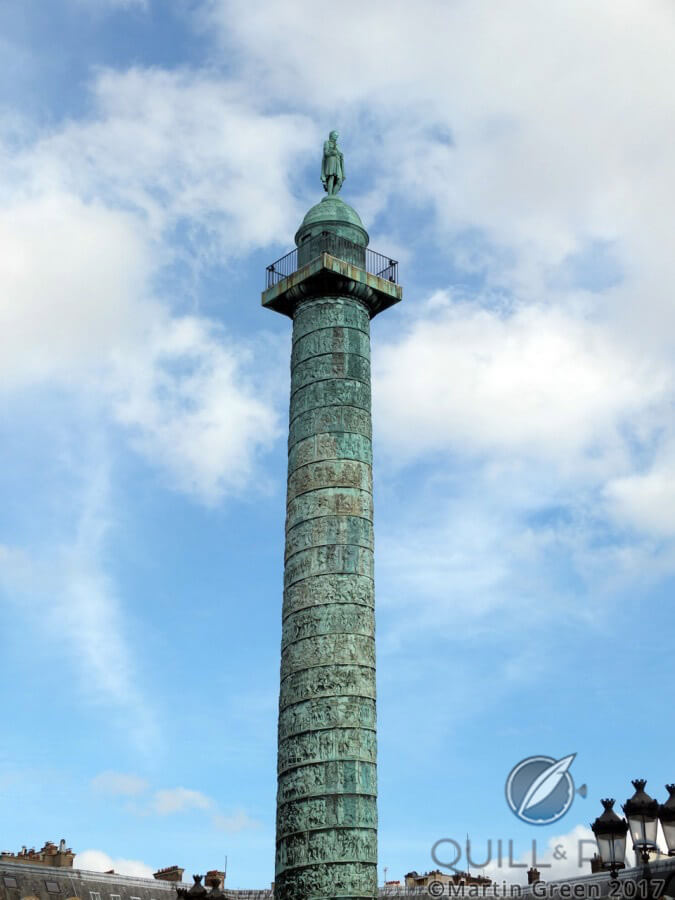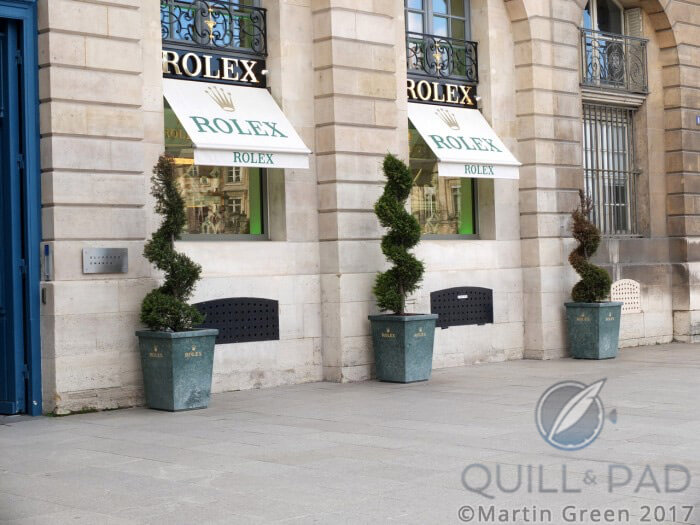The Horological History Of Place Vendôme, Paris
by Martin Green
The grandeur of Place Vendôme is hard to match. And to say that about a location in a city like Paris is quite a statement.
Located a stone’s throw away from the Tuileries gardens, it occupies prime real estate in the French capital. It was Louis XIV, the famous Sun King, who ordered the square build – in honor of himself. and his global fame, both then and now, contributes significantly to the square’s rich history. Despite a rather messy and long incubation period, the square soon became a center of power, where members of the Who’s Who of French aristocracy and plutocracy established themselves in hôtel particuliers, impressive city mansions.

A bird’s eye view of Place Vendôme, Paris
While Place Vendôme changed names several times throughout its 300-year history, and was the stage of gruesome events during some of France’s darkest hours, its appeal has remained strong across the ages.

The Vendôme Column (photo courtesy Martin Green)
Napoleon Bonaparte was quite fond of it, erecting what is now known as the Vendôme Column to commemorate his victory in the Battle of Austerlitz; its bronze bas relief veneer is made of the cannons he captured from the defeated Russian and Austrian armies. This column was toppled by the Paris Commune in 1871 and rebuilt again in 1875.
After that, the square settled slowly into its new role as the epicenter of fashion and luxury.
Historic houses of Place Vendôme
Of course, it would still be a few years before the grand square would start its horological contribution to history, but the first groundwork was laid as early as 1812 when Marie-Étienne Nitot, founder of Chaumet, purchased No. 15. Later, the brand moved to 12 Place Vendôme, where it remains located until today.
This address itself is quite significant, as Frédéric Chopin spent his final days in one of the apartments at this address, passing away there in 1849.

Boucheron Reflet from 1947
It was 1893 when Frédéric Boucheron laid claim to 26 Place Vendôme, a prime location. And it was here in 1947 that the Reflet watch was born with its rectangular case and signature strap made from a single piece of leather. Famed French chanteuse Edith Piaf bought one of the unisex watches in 1948 after she wrote “Hymne à l’amour.” She became an avid fan and ended up with more than 20 Reflet watches.
In 1898, Place Vendôme received an incredible impulse as César Ritz opened what would redefine the concept of a luxury hotel. This opulent luxury provided the square with a constant stream of wealthy visitors from all around the world. It might have also played a role in the decision by Van Cleef & Arpels to move from Rue Drouot to 22 Place Vendôme.
This was also the place where Pierre Arpels designed his dream watch in 1949. For this, he took advantage of an innovative lug design by Louis Cartier, whose patent had just expired (full explanation of that in Van Cleef & Arpels Pierre Arpels: An Intertwined History). That watch became an icon in the collection of Van Cleef & Arpels, but the lugs gained even more fame as Cartier started using them again in its own designs, most prominently in the Pasha de Cartier.

Filming a scene in Paris outside the Cartier boutique at 13 Rue de la Paix for the ‘Grace of Monaco’ movie; note the visible Vendôme Column on Place Vendôme in the background
Close by, but not officially on Place Vendôme, Cartier preferred 13 Rue de la Paix (one of the streets connecting Place Vendôme to the rest of Paris) instead of the square itself to house its flagship boutique.
In 1946 another great jeweler came to Place Vendôme: Mauboussin took residence in number 20. While better known for its jewelry than its watches, some might remember the Fouga wristwatch. And the brand did have a well-known director in the 1990s: none other than Richard Mille. But as Mauboussin decided to target the lower market segments, Richard Mille left to take aim at the tip of the haute horlogerie pyramid with his own brand. And we all know how that played out.
Famous visitors and inspired watches of Place Vendôme
Thanks to the Ritz, Place Vendôme saw its fair share of famous visitors, from maharajas and the Prince of Wales to Ernest Hemingway. The Ritz was this literary giant’s home away from home, and he spent so much time in the bar of the hotel that it was eventually named after him. On his wrist was always one of his Rolex models, a sensible choice for a man who was as much an adventurer as he was a writer.

Bar Hemingway in the Paris Ritz hotel
He was not the only one that liked the Ritz: Coco Chanel lived there for more than 30 years. While Coco never made watches in her lifetime, at a later date Place Vendôme inspired the shape of the Chanel Première watch, a creation that turned 30 years old in 2017.
Chanel was not the only one inspired by the aerial view of the square. When Graff opened its flagship boutique at 17 Place Vendôme in 2016 right next to the Ritz, it also launched a rectangular watch shaped like the square called Place Vendôme. The back of this watch is engraved with the address of the boutique. The thought behind this is that when its owner gets lost in the splendor of the city of light, he or she only has to show the engraving to a cab driver to be dropped off at the Graff boutique, whose employees will ensure that the lost client finds his or her way.

Graff Place Vendôme
Place Vendôme today
Today Place Vendôme is considered even more horological than ever before, with a veritable Who’s Who residing at the square. Boucheron and Van Cleef & Arpels never left, and neither did Chaumet and Mauboussin. They were joined by Piaget, Bulgari, Blancpain, Jaeger-LeCoultre, Louis Vuitton, Hublot, and Patek Philippe. And, yes, even Swatch has claimed a place on the prestigious square.

Rolex boutique on Place Vendôme
If Ernest Hemingway were still alive today, he also probably would never have left Place Vendôme, as in 2008 a Rolex boutique opened right next door to the Ritz. Three stories large, the floors are all connected by a spiral staircase crafted in bronze, glass, and green marble. While the top two floors showcase Rolex’s current collection, the basement serves as a museum.

Historic Breguet pocket watch in the Breguet boutique on Place Vendôme, Paris
Special mention also goes to the boutique of Breguet, located at 6 Place Vendôme. While the master watchmaker who lent his name to this Swatch Group-owned brand never worked or lived on the square, many of his clients did.
This boutique not only has nearly the full Breguet collection on display, it also houses a museum dedicated to the master himself, whose workshop was on Paris’s Quai de l’Horloge, and showcases a number of watches he made during his lifetime. If that is not special enough, a vault is the secure storage space of more than two centuries’s worth of technical drawings and sales ledgers from the brand, some even in Abraham-Louis Breguet’s own handwriting.

Van Cleef & Arpels boutique on Place Vendôme
Place Vendôme has enjoyed a fascinating history that made a unique contribution to the world of haute horlogerie. Today more then ever, it is a place to see and shop for some of the rarest and most extraordinary watches in the world. That alone makes the square for many watch connoisseurs the beating heart of Paris!
You may also be interested in Hotel de Vendôme In The Heart Of Paris: Now Owned By Chopard.
Quick Facts Graff Vendôme
Case: 40 mm, white or pink gold
Movement: unspecified automatic caliber, 42-hour power reserve
Functions: hours, minutes, seconds; date
Price: upon request





















































Mauboussin in Place Vendome has another claim to fame. It is the jewellery that Alain Delon robs in The Red Circle, a 1970’s movie. The heist scene is sublime, about half an hour of pure tension without any dialogue whatsoever.
I didn’t know that, thank you for sharing! I will definitely need to look up this movie and watch it!
from http://www.czapek.com: “The new collection is named Place Vendôme, after the famous square in Paris where François Czapek, spiritus rector of the brand, opened a boutique in the mid-nineteenth century, assumed to be the first haute horlogerie boutique ever on this world famous square.”
Hi Mike,
Do you know at which number Czapek supposedly had his boutique? I have a list of the owners of the different hôtel particuliers from when the square was first created until now, but Czapek isn’t listed on this as an owner, nor as somebody who rented. It could have been a sub-lease though, that is why I am curious about which number his boutique was located at.
For example, Ferdinand Berthoud is listed as a tenant of No. 21 in 1807, but I am still researching if he just lived there or also worked there as well. In those days it was a very fashionable place to live and although technically the apartments were large enough to have a workshop in, this wasn’t necessarily the case.
Hi Martin, Francois Czapek had it’s Czapek and Cie boutique on the number 23 (today Maison Cartier) and then on N.25 (today LV) in the 50’s znd 60’s. I will send you later the findings from historian P.Y. Donzé.
Thanks Xavier! Looking forward to read this and add this to my own research of Place Vendome!
We spent some time viewing and visiting some of the maisons at Place Vendôme last Monday…
JUST LOOKING !!!!!!!!!!
Hi Steve,
That is a joy by itself! Did you see the exhibition upstairs at the Breguet boutique? Also, which boutique was your favorite?